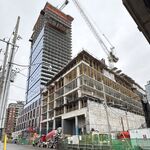A
AlvinofDiaspar
Guest
From the Post:
Fighting to save the past
Heritage group Enlists Famous Supporters
Glynnis Mapp, National Post
Published: Friday, December 29, 2006
There are more than 20 forts, industrial sites, wharves and other historical sites buried under Toronto's waterfront that will be destroyed if Toronto's heritage organizations remain quiet, an archeology activist says.
"Heritage organizations have become complacent and they haven't been fussed about the rapid pace of growth ... when something has been destroyed, they haven't really protested about it," said Michael Gregg, a prehistory instructor at Trent University who lives in Toronto.
Mr. Gregg and other activists have created the Preserve Archaeological Sites of Toronto (PAST) Coalition. They have posted an online petition seeking to garner more than 1,000 signatures.
Among the names listed are curators from the Royal Ontario Museum; archeology professors from the University of Toronto, Trent University, and Laurentian University; and former mayoral candidate Jane Pitfield.
Their latest battlefront is the city's April, 2003, Central Waterfront Secondary Plan, which outlines new developments for the East Bayfront and Don Lands area. The Ontario Municipal Board will rule on the plan in March, after hearings with Mr. Gregg and lawyers representing the City of Toronto, the Toronto Waterfront Revitalization Corporation (TWRC), developers and landowners.
Mr. Gregg, who will be representing himself, said the destruction of Toronto's waterfront has already begun. He said parts of the Queen's Wharf, east of Bathurst Street, were destroyed in April, 2006, despite being listed in 2003 with the city's archeological master plan.
Mr. Gregg said Ron Williamson, chair of Heritage Toronto and project director for Heritage Services, which issued the master plan, sat by while the site was destroyed: "Historical sites are still being built over and nothing much is being done about it.''
But Mr. Williamson said he had no control over the demise of Queen's Wharf. He describes Mr. Gregg's approach as "aggressive" and "tenacious," and said the city and heritage organizations have the same goals, but said any response must be ''balanced.''
"It's almost impossible to suddenly stop in mid-construction, that's something that should be taken care of in planning years before ... the city would be riddled with lawsuits if they stopped [big building] projects," Mr. Williamson said. "We can only deal with sites that can realistically be saved. We're eager to see how [the TWRC] is going to address this --it won't happen overnight."
Mr. Gregg said one priority must be to preserve the Knapps Roller Boat, a 19th-century 110- foot cylindrical boat thought to be buried under a parking lot near Frederick Street and Queen's Quay. He also lists the "Grand Trunk Railway Shop, Toronto Street Railway Stables, and the working class neighbourhood clustered around the Palace Street School," as sites to be preserved. "There's a lot of archeological history here but nobody has actually taken the time to decide what to do with it," Mr. Gregg said.
Kristin Jenkins, vice-president of communications at the TWRC, said the agency has identified the Knapps Roller Boat and has placed a hold on the the land, but has not made plans for the area.
Mr. Gregg hopes to make communication between Ontario's 13 leading heritage groups and TWRC mandatory through the Ontario Ministry of Culture, which funds many of Toronto's heritage organizations.
- - -
A USER'S GUIDE TO TORONTO'S ARCHEOLOGICAL HOT SPOTS
WEST
W1:W. Lakeshore Parcel This land housed Toronto summer cottages during the 19th century.
W2: Fort Rouille This trading post, used as anout station to Fort Niagara, was built by the French in 1751. The French burned the fort after it was abandoned with the fall of Fort Niagara in 1759. The entire site has yet to be fully excavated and a possible French burial ground still exists within the CNE grounds.
W3: The New Fort This was rebuilt to house members of the 4th Battalion of the Royal Artillery and later the Royal Canadian Regiment and Royal Canadian Dragoons. The New Fort was later named the Stanley Barracks.
W4: Central Prison Working prisoners in the 336 cells served the Canada Car Company, which built railway cars. The prison was known for its brutality, and its first warden was accused of abusing prisoners.
W5: Great Western Railway Engine House The third railway company to enter the Toronto railway market shared its line with the Grand Trunk Railway at Union Station. The line first operated from a line located in Hamilton and was finished in 1855 in Toronto. Archeological remains in an engine house and turntable are thought to be in this area.
W6 (A-D): Old Fort York Believed to house the remains of War of 1812 soldiers, after Park- Blackwell Company demolished the fort's guardhouse. Twentieth- century lake filling extended the shoreline several hundred metres, landlocking Fort York.
W7: Grand Trunk Railway House Site of a pumping house, temporary passenger station, and the possible burial site of War of 1812 soldiers.
W8: Queen's Wharf Used as a military wharf for the British garrison at Fort York. Was built over in April, 2006, and a small portion was recovered and relocated to Fort York.
CENTRAL
C1: Canada Pacific Railway The first 15 stalls and the turntable of the Canadian Pacific Roundhouse were completed in 1897 in an area between the present day CN Tower and the John Street Roundhouse. Construction in 1893 created the "New Windmill Line," creating deep-water piers to eliminate dredging (which allowed boats with a draft deeper than 10 feet to be used).
C2: The Commodore Jarvis
Although its use remains much of a mystery, it's assumed that this small oak-framed, 109- by 27-foot vessel hull was used to landfill the area and as a training ship. It burned at the dock, allegedly due to a faulty heating system. The ship was excavated on the site of the Air Canada Centre.
EAST
E1: Polson Ironworks and the Knapps Rollerboat Polson Ironworks set itself up as a successful centre for steel work near the Great Lakes in 1883, to build boilers and general-purpose motors. The site featured the Knapps Rollerboat, a 19th-century, 110-foot cylindrical boat, thought to be buried under a parking lot near Frederick Street and Queen's Quay.
E2: Parliament Buildings As ordered by Lieutenant-Governor Simcoe, the first Parliament buildings -- two brick buildings finished in 1797 -- were used for public events and meetings.
E3: Gooderham and Worts Distillery This distillery held a wind-powered gristmill on the harbour, owned by the Gooderham family in 1832. The Distillery was sold in 1926 and the buildings were used for storage, lumberyards and junkyards.
E4: Cherry Street Dry Dock
Believed to be placed at the north end of Cherry Street, this dry dock was associated with the Toronto Dry Dock and Shipbuilding Company and the Don River.
E5: Sandbar, Peninsula and the Port Industrial District
Natural sandpit connected the waterfront to a peninsula known as Fisherman's Island. Early dock walls and cribbing are said to be located near the northeast corner of the site. The walls were formed by the sands eroded from the Scarbourough Bluffs.
SOUTH
T1: Toronto Islands A combination of natural conditions produced this five-mile long peninsula. Sand-bearing currents to the east, westerly winds and the outflow of the Don River created the Toronto Islands. Gibraltar Point is the furthest western portion of the peninsula and the location of the island airport.
The Archaeological Master Plan of the Central Waterfront, City of Toronto, Ontario, from Toronto Heritage Services
© National Post 2006
AoD
Fighting to save the past
Heritage group Enlists Famous Supporters
Glynnis Mapp, National Post
Published: Friday, December 29, 2006
There are more than 20 forts, industrial sites, wharves and other historical sites buried under Toronto's waterfront that will be destroyed if Toronto's heritage organizations remain quiet, an archeology activist says.
"Heritage organizations have become complacent and they haven't been fussed about the rapid pace of growth ... when something has been destroyed, they haven't really protested about it," said Michael Gregg, a prehistory instructor at Trent University who lives in Toronto.
Mr. Gregg and other activists have created the Preserve Archaeological Sites of Toronto (PAST) Coalition. They have posted an online petition seeking to garner more than 1,000 signatures.
Among the names listed are curators from the Royal Ontario Museum; archeology professors from the University of Toronto, Trent University, and Laurentian University; and former mayoral candidate Jane Pitfield.
Their latest battlefront is the city's April, 2003, Central Waterfront Secondary Plan, which outlines new developments for the East Bayfront and Don Lands area. The Ontario Municipal Board will rule on the plan in March, after hearings with Mr. Gregg and lawyers representing the City of Toronto, the Toronto Waterfront Revitalization Corporation (TWRC), developers and landowners.
Mr. Gregg, who will be representing himself, said the destruction of Toronto's waterfront has already begun. He said parts of the Queen's Wharf, east of Bathurst Street, were destroyed in April, 2006, despite being listed in 2003 with the city's archeological master plan.
Mr. Gregg said Ron Williamson, chair of Heritage Toronto and project director for Heritage Services, which issued the master plan, sat by while the site was destroyed: "Historical sites are still being built over and nothing much is being done about it.''
But Mr. Williamson said he had no control over the demise of Queen's Wharf. He describes Mr. Gregg's approach as "aggressive" and "tenacious," and said the city and heritage organizations have the same goals, but said any response must be ''balanced.''
"It's almost impossible to suddenly stop in mid-construction, that's something that should be taken care of in planning years before ... the city would be riddled with lawsuits if they stopped [big building] projects," Mr. Williamson said. "We can only deal with sites that can realistically be saved. We're eager to see how [the TWRC] is going to address this --it won't happen overnight."
Mr. Gregg said one priority must be to preserve the Knapps Roller Boat, a 19th-century 110- foot cylindrical boat thought to be buried under a parking lot near Frederick Street and Queen's Quay. He also lists the "Grand Trunk Railway Shop, Toronto Street Railway Stables, and the working class neighbourhood clustered around the Palace Street School," as sites to be preserved. "There's a lot of archeological history here but nobody has actually taken the time to decide what to do with it," Mr. Gregg said.
Kristin Jenkins, vice-president of communications at the TWRC, said the agency has identified the Knapps Roller Boat and has placed a hold on the the land, but has not made plans for the area.
Mr. Gregg hopes to make communication between Ontario's 13 leading heritage groups and TWRC mandatory through the Ontario Ministry of Culture, which funds many of Toronto's heritage organizations.
- - -
A USER'S GUIDE TO TORONTO'S ARCHEOLOGICAL HOT SPOTS
WEST
W1:W. Lakeshore Parcel This land housed Toronto summer cottages during the 19th century.
W2: Fort Rouille This trading post, used as anout station to Fort Niagara, was built by the French in 1751. The French burned the fort after it was abandoned with the fall of Fort Niagara in 1759. The entire site has yet to be fully excavated and a possible French burial ground still exists within the CNE grounds.
W3: The New Fort This was rebuilt to house members of the 4th Battalion of the Royal Artillery and later the Royal Canadian Regiment and Royal Canadian Dragoons. The New Fort was later named the Stanley Barracks.
W4: Central Prison Working prisoners in the 336 cells served the Canada Car Company, which built railway cars. The prison was known for its brutality, and its first warden was accused of abusing prisoners.
W5: Great Western Railway Engine House The third railway company to enter the Toronto railway market shared its line with the Grand Trunk Railway at Union Station. The line first operated from a line located in Hamilton and was finished in 1855 in Toronto. Archeological remains in an engine house and turntable are thought to be in this area.
W6 (A-D): Old Fort York Believed to house the remains of War of 1812 soldiers, after Park- Blackwell Company demolished the fort's guardhouse. Twentieth- century lake filling extended the shoreline several hundred metres, landlocking Fort York.
W7: Grand Trunk Railway House Site of a pumping house, temporary passenger station, and the possible burial site of War of 1812 soldiers.
W8: Queen's Wharf Used as a military wharf for the British garrison at Fort York. Was built over in April, 2006, and a small portion was recovered and relocated to Fort York.
CENTRAL
C1: Canada Pacific Railway The first 15 stalls and the turntable of the Canadian Pacific Roundhouse were completed in 1897 in an area between the present day CN Tower and the John Street Roundhouse. Construction in 1893 created the "New Windmill Line," creating deep-water piers to eliminate dredging (which allowed boats with a draft deeper than 10 feet to be used).
C2: The Commodore Jarvis
Although its use remains much of a mystery, it's assumed that this small oak-framed, 109- by 27-foot vessel hull was used to landfill the area and as a training ship. It burned at the dock, allegedly due to a faulty heating system. The ship was excavated on the site of the Air Canada Centre.
EAST
E1: Polson Ironworks and the Knapps Rollerboat Polson Ironworks set itself up as a successful centre for steel work near the Great Lakes in 1883, to build boilers and general-purpose motors. The site featured the Knapps Rollerboat, a 19th-century, 110-foot cylindrical boat, thought to be buried under a parking lot near Frederick Street and Queen's Quay.
E2: Parliament Buildings As ordered by Lieutenant-Governor Simcoe, the first Parliament buildings -- two brick buildings finished in 1797 -- were used for public events and meetings.
E3: Gooderham and Worts Distillery This distillery held a wind-powered gristmill on the harbour, owned by the Gooderham family in 1832. The Distillery was sold in 1926 and the buildings were used for storage, lumberyards and junkyards.
E4: Cherry Street Dry Dock
Believed to be placed at the north end of Cherry Street, this dry dock was associated with the Toronto Dry Dock and Shipbuilding Company and the Don River.
E5: Sandbar, Peninsula and the Port Industrial District
Natural sandpit connected the waterfront to a peninsula known as Fisherman's Island. Early dock walls and cribbing are said to be located near the northeast corner of the site. The walls were formed by the sands eroded from the Scarbourough Bluffs.
SOUTH
T1: Toronto Islands A combination of natural conditions produced this five-mile long peninsula. Sand-bearing currents to the east, westerly winds and the outflow of the Don River created the Toronto Islands. Gibraltar Point is the furthest western portion of the peninsula and the location of the island airport.
The Archaeological Master Plan of the Central Waterfront, City of Toronto, Ontario, from Toronto Heritage Services
© National Post 2006
AoD




